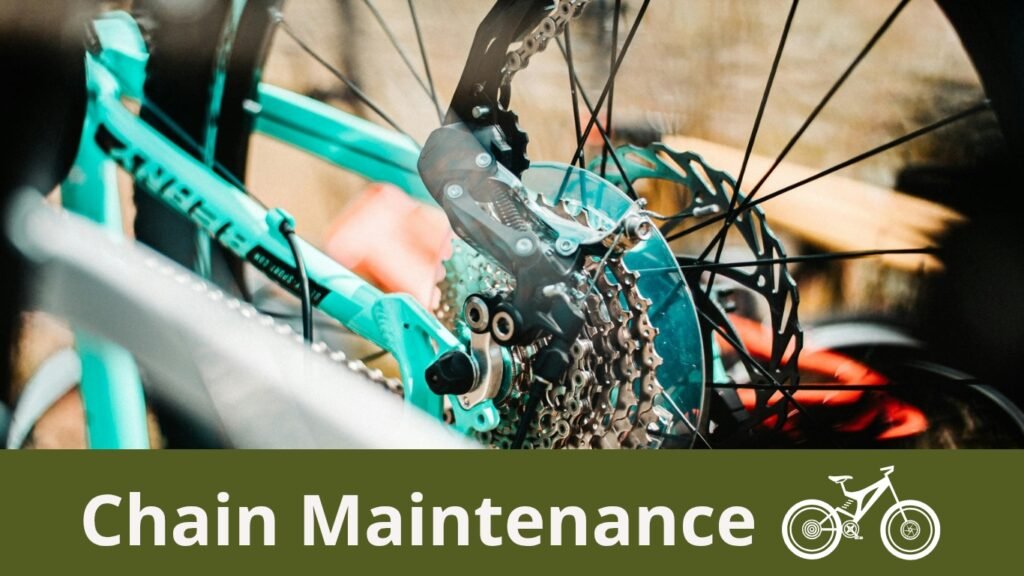Have you ever heard an awful sound coming from the bike chain? Or faced any problems while shifting gears? Well, it happens with many bikers who overlook mountain bike chain maintenance.
It’s the common reason behind poor gear shifting and loss of power, and sometimes, you even have to pay for the repair cost of an expensive drivetrain.
So why waste time and money when you can maintain your mountain bike’s chain at home?
In this guide, we will discuss how to do mountain bike chain maintenance, how to clean and lube your chain, how often you should do it, mistakes to avoid, and many more things.
Also read: How to do Regular Mountain Bike Maintenance at Home
Is Chain Maintenance essential, and why does it matter?

The mountain bike chain is the most important part, and it continuously works from the time you start riding the bike until you stop.
Your bike’s chain gets constantly exposed to dirt, mud, sand, water, and grit, especially during off-road.
Every time this debris builds up, it is harmful to your bike’s drivetrain and also reduces efficiency.
That’s why chain maintenance is very important to keep the ride smooth.
What Happens When You Ignore Chain Maintenance?
If you avoid regular mountain bike maintenance, it will negatively affect the bike’s chain because the dirt acts like sandpaper, which gradually grinds down your bike’s chain and cassette teeth.
It even makes the chain so weak that you have to replace it.
Besides this, if the chain is poorly lubricated, you won’t feel right while shifting gears smoothly, which is really frustrating.
Also, the dirt and grime on the chain causes it to stretch, which causes the chain to fail (again, you may have to replace it, as it’ll decrease chain working duration).
The weirdest thing is that you will hear a creaking or squeaking sound because when the chain struggles to move smoothly, it will be very disturbing; it will distract you and also ruin your experience.
That’s why, to avoid all these things, mountain bike chain maintenance is important, and it only takes 10-15 minutes per session.
So, it’s better to do simple mtb maintenance at home for better performance to improve performance and to save money on repairs.
Also read: 4 week Mountain bike training program for bikers
How Often Should You Clean and Lube Your Chain?
There are many reasons that will determine how often you should clean and lube your mountain bike chain.
Let’s say you have a mountain bike that you don’t use frequently; you just use it once or twice a month on a smooth road.
In that case, you don’t have to do a lot of maintenance.
On the other hand, if you use it once or twice a week in muddy areas, you will need to clean it more often than while riding in smooth areas.
However, here are some general guidelines that will help you determine when to clean and lube your mtb bike’s chain.
Basic Guidelines for Maintenance;
If you are riding through a muddy area, the chain will get dirt quickly and damage your chain.
So, you want to clean it immediately after the ride to prevent debris from grinding down your drivetrain.
Besides this, after every 100 to 150 miles in dry conditions, dust, dirt, and grit can accumulate on the chain. That’s why you will still want to lubricate the chain for a smooth performance.
Every time before a long ride, a race, or a trip, you can clean and lube your chain to avoid noisy or sluggish chains. (How to plan a MTB trip to Europe)
Plus, if you see your chain has started squeaking, it means you need to do bike chain maintenance.
For example, you can hear a kind of cracking sound from the chain.
A quick tip: You can also carry a small bottle of lube in your pocket if you go on a mountain bike trip for multiple days.
Also read: Essential Mountain Biking Safety Tips to Protect Yourself
Tools You’ll Need for Chain Cleaning

You don’t need a full workshop to clean your bike’s chain at home because it is very simple to do it even at home without any tools.
However, it’s better to have some tools to make the chain cleaning process more easy. Here are some tools:
You can have a degreaser to cut through grease, grime, and any buildup on the chain. It can also break down dirt and oil quickly, plus it makes the cleaning process easier.
Besides this, you can use a chain cleaning tool or stiff bristle brush to scrub your chain’s efficiency. It will help you reach those hard spots where your finger can’t.
You can also have a lint-free rag or microfiber cloth to wipe down the chain after cleaning.
You will use it to clean your bike’s chain to remove excess degreaser and dry off your chain before applying lube.
However, before applying lube, you want to choose the lube depending on the condition, whether it is wet or dry.
Lastly, you will need a chain checker tool and gloves.
A chain checker tool will help you measure the wear on your chain, and it can tell you when to replace the chain completely.
Also read:
- Important gears for Mountain biking every biker should have
- 27 Best Mountain bike trails in the USA to visit
Step-by-Step: How to Clean Your Chain
So here is a step-by-step process that will help you clean your mountain bike chain.
Smallest chainring and
First of all, you want to shift the smallest chainring and cog, as it makes it easier to access the chain and gives you more room to work more effectively on cleaning.
Apply degreaser
You want to use a spray or a brush degreaser on the chain while rotating the pedal backward.
But make sure the degreaser covers the entire chain length. Before that, you can also soak it for 2-3 minutes to break down grease and grime.
Scrub the Chain
You can use a chain cleaning tool or a stiff-bristled brush to scrub the chain and remove dirt and debris, which you often get after a muddy or dusty ride.
Most importantly, don’t forget to clean the cassette and chain ring as well because they also collect dirt.
Rinse with Water
Rinse the chain with low water pressure to wash off the degreaser and clean dirt, but make sure you are not forcing water into the bearings.
Dry Completely
Finally, you can use a clean rag or a piece of cloth to clean and dry the chain. You want to wipe down the chain until it is not dry.
Water can lead the chain to rust, which is even worse than having dust or mud on the chain. After that, you want to do the lubrication process.
Also read: How to Fix Flat Tire of Your Mountain Bike
Step-by-Step: How to Lube Your Chain

After cleaning the chain, it’s time for lubrication. So here is the step-by-step process of how to lube a mountain bike chain.
Pick the Right Lube
First of all, you want to choose the lube for your bike. There are two types of lube: a dry lube and a wet lube.
The dry lube is better for dusty and dry conditions. It doesn’t attract dirt, but you have to apply it more frequently than wet lube.
However, the wet lube is good for muddy rides.
It will last longer, but the bad thing is that it will attract dirt, so you have to clean your bike more frequently.
Apply a Small Amount of Lube
Once you have the lube, then apply it.
You want to slowly backpedal and apply a little lube directly to the rollers (Avoid side plates).
Apply lube where it will do the most good, which is the moving part of your can.
Let It Soak In for 5–10 Minutes
Let the lube penetrate deep into the links for better lubrication so that it can last longer, provide better protection, and provide a smooth experience.
Wipe Off the Excess
You can use a piece of cloth to clean excessive lube because if you apply excessive amounts, it will attract dirt, and it will also make your bike a sticky, gunky mess.
Common mistake: Many riders make a mistake by applying too much lube, thinking it will improve performance, but that’s wrong. It attracts more dirt and dust, which is why it is good in a limited amount.
Common Chain Maintenance Mistakes to Avoid

There are a few common mistakes that many riders make, because of which you have to do more maintenance.
However, if you avoid these mistakes, you can keep your bike in top condition without too much maintenance.
Skipping Cleaning After Muddy Rides
Skipping cleaning after any muddy rides is the biggest mistake because the mud dries like cement, which quickly grinds down chains and other drivetrain components.
That’s why whenever you come back home after a muddy ride, you want to clean the bike first to prevent it.
Over-Lubing
Don’t apply too much lube, as I have also discussed before; it attracts dirt and debris and causes gunky buildup on the chain.
Using the Wrong Lube
Don’t use substances like WD-40 or cooking oil. I even made the mistake of using coconut oil in the beginning, but please don’t do it.
They do not protect the chain. Instead, they cause more damage. Just stick to specific bike lubricants for a better bike.
Not Checking for Wear
The bike chain stretches over time, and it damages your cassette.
That’s why you can use a chain monitor tool to monitor wear and replace the chain before it becomes a headache for you.
Ignoring Rust
Rust is a sign that moisture is penetrating your chain.
So, if you spot it, then immediately clean and lubricate your bike chain to prevent rust from spreading. Because it is the most dangerous thing that can happen to your bike.
Also read: Common mountain bike injuries and their prevention
When to Replace Your Chain
It doesn’t matter how good your bike’s chain is; it won’t last forever. There will be a time when you have to change it. But when?
Well, usually, you can replace it after riding for 750 to 1500 miles, but it also depends on many factors when to replace the chain.
Like riding conditions, how you maintained them over a period of time, etc.
Here is how you can predict that it’s time to change.
Use a Chain Wear Tool
You can use a chain-wear tool to see what it says. If the tool reads 0.5% wear, then you can start thinking about replacing the chain.
However, once it gets 0.75%, you can replace the chain immediately to avoid any damage to the cassette and chain ring.
Because after 0.75%, the chain will start causing more damage to other components, too, which will eventually cost more repair cost.
Check for Stiff Links or Visible Rust
You can look for two signs: stiff links and rust.
The stiff link is a sign that the chain is losing its flexibility, and you won’t be able to fix the gear smoothly for a longer time.
Especially when you see that despite cleaning, the stiff link is not loosened up, so it means you need to replace it.
On the other hand, rust indicates that your bike’s chain is exposed to moisture for a long time. Because it doesn’t come overnight, it takes a lot of time.
Plus, it won’t go off from regular cleaning too. So, it’s a sign you need to replace the chain to prevent further damage to the bike’s other components.
Pro Tip: When you notice that you need to replace the chain, please go for it. It will just cost $30 to $40, but it is still a much better option than later paying $150 for a cassette or $200 for a chainring.
So replace the chain as soon as you notice any of the things that we have discussed.
Bonus Tips for Peak Performance

Taking care of your mountain bike chain is more than just cleaning and lubing the chain.
Here are some additional tips; if you follow them, you can get the most out of your chain and drivetrain.
Avoid Cross-Chaining
You want to avoid cross-chaining, which occurs often when you ride in extreme gear combos like Big Chainring and Cog.
They create an unnecessary strain on the bike’s chain and wear it faster.
So, make sure you stay in a moderate gear range to keep your chain and components safe.
Store Your Bike Indoors
Sometimes, even storing a bike outside of the home can expose it to moisture, because of which rust will occur.
So, you want to store it indoors, and the place needs to be dry and cool to prevent anything like that.
Check Chain Tension
A loose chain can also slip around, causing excessive wear to the drivetrain component.
You can regularly check tension and adjust your chain’s tension as necessary to prevent any damage and maintain smooth gear shifting.
Inspect After Crashes
After any hard fall or crash, you want to inspect the chain for any damage, like bent links or misalignment, and fix it immediately.
Conclusion
Hearing weird sounds from the bike’s chain is really frustrating. But it happens when you avoid regular maintenance.
Not just sound, you face difficulties while shifting gears. So, if you want to get rid of this headache, you need to clean and lube the mountain bike chain regularly.
It will just take 10-15 minutes for regular maintenance, and in return, you will get a smoother ride and chain that will last longer without being replaced.
So now just grab your degreaser, brush, and lube (based on riding condition) and show some love to your bike.
Can I use WD-40 on my bike chain?
No, please don’t use WD-40, as it is not a suitable lubricant for mountain bike chains.
Yeah! It works as a degreaser. However, it is not designed to provide long-lasting protection, which is important during a longer ride.
You can use it to clean grime but not as a lubricant to protect the chain from wear.
However, you can use specific chain lubes that are specifically designed for your riding condition, such as wet or dry lube.
How often should I replace my bike chain?
Well, there is no specific time limit for replacing your mountain bike chain. However, after riding up to 700 miles to 1500 miles, you can think about replacing it.
But before that, you can use a chain checker tool. If the chain reaches 0.75% wear, you can replace the chain to avoid further damage.
However, it also depends on various factors, like if you are riding too much in muddy areas or on rainy trails.
In such a situation, you will have to replace the chain more quickly.
On the other hand, when you are not maintaining the chain on a regular basis, it will decrease the chance of replacement; you can also notice some signs such as rough shifting, excessive noise, etc.
Is wet lube better than dry lube?
Well, it depends on your riding condition. Wet lube is better during muddy rides as it provides better protection, and dry lube works better in dusty and dry conditions as it doesn’t attract much dirt.
So, based on your riding condition, you have to choose the best one. They both are good but for a specific condition.
What happens if I don’t lube my chain?
If you don’t lube your mountain bike chain, you may face three problems. The first is the squeaking, poor gear shifting, and faster wear.
That’s why you want to lube the chain for better performance and to save money on replacing it as a whole.
Do I need to lube a new chain?
Yes, of course, you can apply lube to the new chain before riding on it because they typically come with factory layer grease to prevent rust during shipment.
But it is not designed for actual riding. That’s why you want to clean off that grease with a degreaser and then apply lube based on your riding condition.
How can I clean my bike chain without a degreaser?
If you want to clean your bike’s chain without a degreaser, then you will need warm water with a few drops of dish soap, and you will soak the chain in it for a few minutes.
After that, you will need to use an old toothbrush to scrub and remove any dirt. Then, you will rinse the chain with clean water and dry it.
Finally, you can apply bike lubricant to the chain’s inside while pedaling backward. However, don’t forget to wipe off any excessive dirt or anything else.

Ali is the founder of Mountain Bike Insider and an passionate rider with years of hands-on experience in mountain biking. From testing gear to exploring trails, Ali writes based on real riding knowledge to help others make smart, safe, and enjoyable biking choices. Every guide is built on research, personal use, and a passion for the sport.







